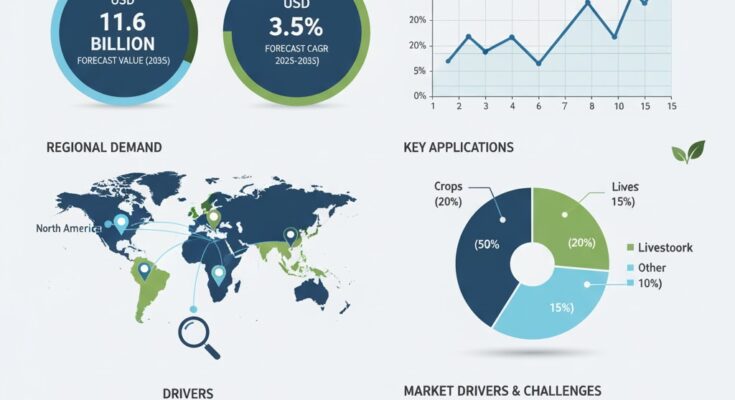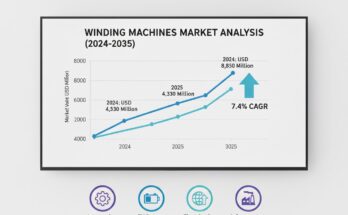The global agricultural sprayers market stands at the threshold of a decade-long expansion trajectory that promises to reshape crop protection technology and precision farming solutions. Valued at USD 8.4 billion in 2025, the market is projected to reach USD 11.6 billion by 2035, expanding at a CAGR of 3.5% over the forecast period, according to the latest insights from Fact.MR.
Growing emphasis on efficient pesticide and fertilizer application, technological innovation in sprayer design, and government support for smart farming initiatives are propelling demand for advanced agricultural sprayers across both developed and emerging economies. These systems, ranging from handheld units to drone-based and autonomous sprayers, are transforming the way farmers optimize yields while minimizing input waste and environmental impact.
Market Drivers: Automation, Precision Agriculture, and Sustainability
Rising Adoption of Precision Agriculture
The global shift toward precision farming is fueling the adoption of technologically advanced agricultural sprayers that ensure targeted, uniform, and efficient chemical distribution. These sprayers minimize resource wastage, reduce operational costs, and enhance productivity by enabling real-time monitoring and data-driven decision-making. Modern sprayers equipped with GPS, GIS, and sensor technologies allow farmers to tailor pesticide and fertilizer applications based on soil health and crop requirements.
Technological Innovations in Sprayer Design
Recent advancements in automated, drone-based, and self-propelled sprayers are redefining operational efficiency in agriculture. The integration of IoT, AI-based systems, and variable rate technologies (VRT) is enabling accurate control over droplet size, spray volume, and pressure. Manufacturers are focusing on lightweight, corrosion-resistant materials and energy-efficient nozzles to enhance durability and sustainability. The growing use of electric and battery-operated sprayers is further promoting eco-friendly farming practices.
Government Initiatives and Sustainable Agriculture Trends
Governments worldwide are promoting mechanization and precision agriculture through subsidies and awareness campaigns, especially in regions like Asia-Pacific and Latin America. These initiatives aim to increase crop yield while reducing chemical overuse. Furthermore, the global push for sustainable agriculture and reduced carbon emissions is driving the development of sprayers compatible with bio-based and organic pesticides, aligning with evolving agricultural sustainability goals.
Competitive Landscape
The agricultural sprayers market is moderately consolidated, with established global players and emerging regional manufacturers focusing on innovation, product expansion, and precision technology integration. Companies are investing in R&D partnerships, AI-enabled spraying systems, and autonomous farm machinery to enhance operational accuracy and profitability.
Key Players in the Agricultural Sprayers Market:
- John Deere
- AGCO Corporation (Hardi, Fendt lines)
- Kuhn Group
- Kverneland Group
- Horsch Maschinen GmbH
- Raven Industries
- Amazone H. Dreyer SE & Co. KG
- TeeJet Technologies
- CropCare Equipment (Regional Player)
- Yanmar Co., Ltd.
These players are strengthening their global footprint through product launches, regional collaborations, and digital platform integration to support precision spraying. The growing demand for drones and automated field equipment is also prompting strategic partnerships between agricultural equipment manufacturers and agri-tech startups.
Recent Developments
- June 2025 – John Deere launched an upgraded autonomous sprayer featuring AI-driven weed detection and ultra-precise droplet control to minimize chemical usage.
- March 2024 – Raven Industries announced a collaboration with Trimble Agriculture to integrate advanced field data analytics into its autonomous sprayer systems, enhancing field coverage and efficiency.
- September 2023 – AGCO introduced its next-generation Fendt Rogator sprayer line, offering dual-use flexibility for both liquid and granular applications, further improving equipment versatility.
Future Outlook: Toward Autonomous and Eco-Friendly Farming
The coming decade will mark a transformative phase in agricultural spraying, driven by the convergence of AI, robotics, and smart farming ecosystems. Key trends include:
- AI-Powered Autonomous Sprayers enabling real-time decision-making and minimal human intervention.
- Drones for High-Precision Spraying across uneven terrains and smaller fields.
- Low-Drift Nozzle Technologies to reduce pesticide wastage and environmental contamination.
- Integration with Farm Management Software for data synchronization and predictive analytics.
By 2035, the agricultural sprayers market will play a pivotal role in achieving sustainable, high-yield, and technology-driven farming, ensuring food security for a growing global population.



